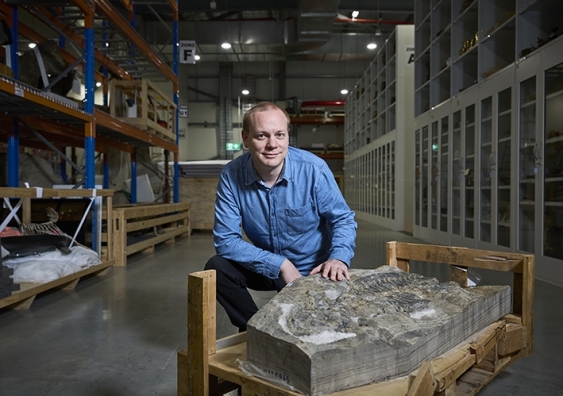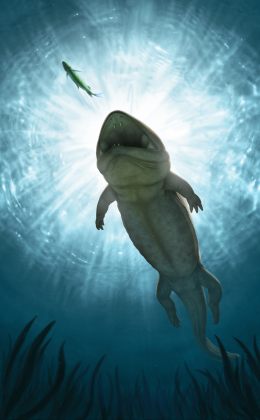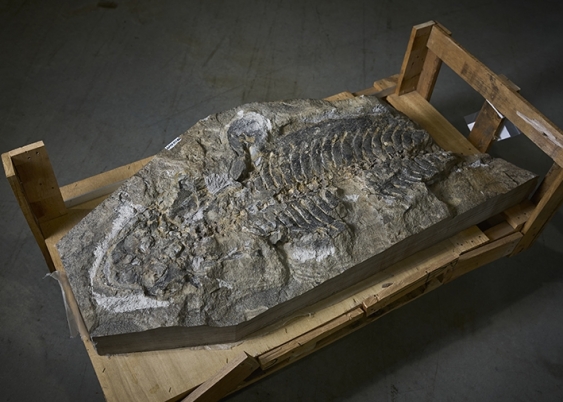Scientists name new species of giant amphibian found in retaining wall
Arenaerpeton supinatus was discovered in rocks cut from a nearby quarry that were intended for the building of a garden wall.
Arenaerpeton supinatus was discovered in rocks cut from a nearby quarry that were intended for the building of a garden wall.

Lachlan Gilbert
╣·├±▓╩Ų▒ News & Content
(02) 9065 5241
lachlan.gilbert@unsw.edu.au
A 240-million-year-old fossil of an amphibian that was found in a retaining wall in the 1990s has been formally named and described by scientists at ╣·├±▓╩Ų▒ Sydney and the Australian Museum.
The fossil was originally found by a retired chicken farmer in rocks obtained from a local quarry intended for use in the construction of a garden retaining wall and was subsequently donated to the Australian Museum in Sydney.

An artist's impression of Arenaerpeton supinatus, the ancestor of today's Chinese Giant Salamander. Image: Jose Vitor Silva
Palaeontologist Lachlan Hart, who holds joint roles with ╣·├±▓╩Ų▒ Science and the Australian Museum, says the fossil ŌĆō named Arenaerpeton supinatus, meaning ŌĆśsupine sand creeperŌĆÖ ŌĆō shows nearly the entire skeleton, and remarkably, the outlines of its skin.
ŌĆ£This fossil is a unique example of a group of extinct animals known as temnospondyls, which lived before and during the time of the dinosaurs,ŌĆØ says Mr Hart, a PhD candidate in the School of Biological, Earth and Environmental Sciences (BEES) at ╣·├±▓╩Ų▒.
ŌĆ£We donŌĆÖt often find skeletons with the head and body still attached, and the soft tissue preservation is an even rarer occurrence.ŌĆØ
Arenaerpeton inhabited freshwater rivers in what is now known as the Sydney Basin during the Triassic period, 240 million years ago. Mr Hart says it most likely hunted other ancient fish such as Cleithrolepis, but apart from that, there is not much evidence that tells us about the other animals that Arenaerpeton shared the land and waters with.
ŌĆ┬┘│▄▒Ķ▒░∙┤┌Š▒│”Š▒▓╣▒¶▒¶▓Ō, Arenaerpeton looks a lot like the modern Chinese Giant Salamander, especially in the shape of its head,ŌĆØ Mr Hart says.
ŌĆ£However, from the size of the ribs and the soft tissue outline preserved on the fossil we can see that it was considerably more heavyset than its living descendants. It also had some pretty gnarly teeth, including a pair of fang-like tusks on the roof of its mouth.ŌĆØ

Arenaerpeton looks a lot like the modern Chinese Giant Salamander. Photo: ╣·├±▓╩Ų▒ Sydney/Richard Freeman
Read more:
Mr Hart says what is exciting about the discovery is that Arenaerpeton is large ŌĆō estimated to be about 1.2m from head to tail ŌĆō when most other closely related animals that lived at the same time were small.
ŌĆ£The last of the temnospondyls were in Australia 120 million years after Arenaerpeton, and some grew to massive sizes. The fossil record of temnospondyls spans across two mass extinction events, so perhaps this evolution of increased size aided in their longevity.ŌĆØ
Dr Matthew McCurry, Senior Lecturer in ╣·├±▓╩Ų▒ŌĆÖs School of BEES and Curator of Palaeontology at the Australian Museum says the fossil is a significant find in Australian paleo history.
ŌĆ£This is one of the most important fossils found in New South Wales in the past 30 years, so it is exciting to formally describe it,ŌĆØ says Dr McCurry, who is also a co-author on the study. ŌĆ£It represents a key part of AustraliaŌĆÖs fossil heritage.ŌĆØ
The study has been published in the , and the fossil will be on display at the Australian Museum, Sydney, later this year.